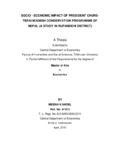Please use this identifier to cite or link to this item:
https://elibrary.tucl.edu.np/handle/123456789/2045| Title: | Socio - Economic Impact of President Chureterai Madesh Conservation Programme of Nepal (A Study in Rupandehi District) |
| Authors: | Kandel, Meena |
| Keywords: | socio-economic;Trends |
| Issue Date: | 2019 |
| Publisher: | Central Department of Economics |
| Abstract: | Chure is socio-economically very significant and environmentally vulnerable, fragile and sensitive area of Nepal. It covers 12.78 percent of the total landscape of the country. Recognizing this, the government has formulated a high level of board “Pesident ChureTerai Madesh Conservation Board” to oversee the conservation activities in this region. Based on this, the study attempts to examine the socio-economic impact and identify the problems and prospects of the programme. Using qualitative and quantitative analysis methods, the study is based on both secondary and primary data. The description of the primary data were collected during the 100 HHs survey in the Devadaha Municipality of Rupandehi District. The study has pointed out that the programme has basically positive impact towards socioeconomic aspects. But some extent, the programme has also found negative aspects. During the period the productive land has decreased from 57.39 percent to 50.91 percent, due to enlargement of settlement area. The availability of alternative irrigation sources is increase in sufficient level form 35 percent to 50 percent, through the recharge pond and dam programme after initiated the programme. Therefore the agricultural production has increased consequently, food sufficiency increased from 42 HHs to 59 HHs above 6 months. Similarly, the sufficiency of the water availability has also increased from 29 percent to 68 percent, where tap is used by 80 HHs. Which is due to the initiative taken by local people, local government and in some level by the programme. Due to the stoppage in the grazing area from the programme, some short of livestock keeping is decreased. Whereas fodder grasses (60.49 percent to 69.62 percent) and timber (55 percent to 66 percent) availability has increased. It is, due to the scientific management by community forest and the prgramme has made those products sufficient. The river products availability has insufficient which has decreased from 59 percent to 39 percent. The reason behind this it is greater implementation of regulation by PCTMCP. It can be concluded that after the implementation of the programme, there is slightly reduction in flood, landslide, illegal trafficking of forest and river products and forest fire. Therefore, the environment programme has achievd the greater progress. However, the programme has many problems, challenges and some prospects as well. So, the study concludes that as the programme being of long term nature, it takes more time to see the impact on socio-economic and environmental protection and conservation practices. The result has not been seen is greater mass at present. It could be hoped to obtain greater benefit in long run, if there is multistakeholder, multidisciplinary as well as multidimensional efforts took place in time. |
| URI: | http://elibrary.tucl.edu.np/handle/123456789/2045 |
| Appears in Collections: | Economics |
Files in This Item:
| File | Description | Size | Format | |
|---|---|---|---|---|
| THESIS.pdf | 4.21 MB | Adobe PDF |  View/Open |
Items in DSpace are protected by copyright, with all rights reserved, unless otherwise indicated.
